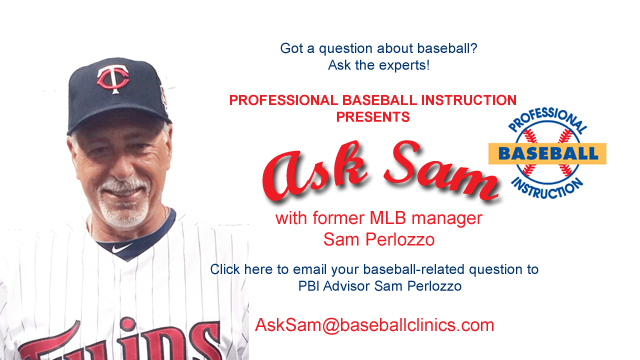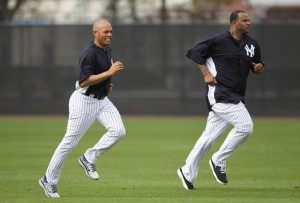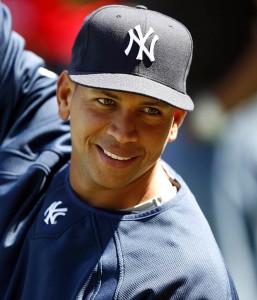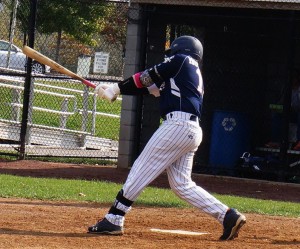
Welcome to the latest “Ask Sam.”
I’m Sam Perlozzo and I’m the minor league infield and baserunning coordinator for the Minnesota Twins. A former manager and coach at the major league level, I am also one of Professional Baseball Instruction’s Major League Advisors. Each month, I answer your baseball-related questions.
 Before we get into this month’s questions, I want to remind you about something brand new that I’m involved in and very excited about. Fellow PBI Advisor Leo Mazzone and I have teamed up with former MLB players Roy Halladay, Dave Magadan, Jody Reed, Tom Foley and others on a new website called Inside Baseball. We offer the world’s largest online library of baseball training videos with proven advice and training methods designed to help baseball players of all abilities improve their game. I hope you’ll take a few moments to check out the website; there’s a lot of excellent information there.
Before we get into this month’s questions, I want to remind you about something brand new that I’m involved in and very excited about. Fellow PBI Advisor Leo Mazzone and I have teamed up with former MLB players Roy Halladay, Dave Magadan, Jody Reed, Tom Foley and others on a new website called Inside Baseball. We offer the world’s largest online library of baseball training videos with proven advice and training methods designed to help baseball players of all abilities improve their game. I hope you’ll take a few moments to check out the website; there’s a lot of excellent information there.
Now, let’s get to your questions. And remember, if you have something you’d like to ask? Email me directly – AskSam@baseballclinics.com.

Photo courtesy New York Post
What do you think? Am I too old school or what? Mahalo (thank you) Bob D.
A: Hi Bob. There is probably no real right answer to your question although I tend to agree with you on your idea. It is customary to run pitchers on days they don’t pitch. The starting pitchers would run on the days they don’t start and not run on the days that they pitch. And I think this is the norm. It could be that the coach doesn’t get enough days to practice and run his pitchers, so he takes advantage of conditioning whenever possible. Realize that relief pitchers have to get their running in on the days they pitch quite often. The difference being they do it early enough during the day so that they have time to recover when called upon to pitch in that nights game.
It seems you are concerned about getting ice on the pitcher’s arm rather quickly. You are not old school just a concerned parent. Since the time it takes to run isn’t such a long process, I would think they have plenty of time to get the ice and still be effective with it. Icing is good for lots of injuries and you don’t always have the time to do it immediately. People sit home and ice several times a day to get good results. These kids can do the same without jeopardizing injury I would think.
So Bob, I would think the sooner the ice goes on, the better. But I wouldn’t be too concerned about the timing. It is also very important to keep their legs stronger so that they have enough stamina so as not to tire too quickly and risk an arm injury that way. They work hand in hand, try and help out the best you can. Thanks again! Good luck! Sam

Photo courtesy Sports Illustrated
A: Jim, I was actually with Seattle when we brought Alex up to the Major Leagues his first time. He was and still is a talented player. In reference to your thoughts on A-Rod getting off to a fast start, I would say he prepared himself very well in the time he had off. I would say he went through spring training with a purpose and was ready to go when the bell rang. It is a long season with lots of games left. Players get off to fast and slow starts; it’s how they react in the long haul.
So, when we seem to be amazed at certain points in the season, I would say we have to let the season play out. He was a heck of a player and now is playing at the end of his career. It becomes harder and harder as we age. Let’s tip our hat to his start and have fun watching the always-great Yankee team play for baseball in October. Thanks Jim. Sam
 Q: Sam – any thoughts on how to help a hitter get his barrel out to the ball a little quicker. My son has always been a good hitter but in the first few games of his spring season, I noticed that he was late on average fastballs. He’s 14 now, and in his 2nd full season on the “big field,” but hasn’t gone through puberty yet. Thanks, Bill in Queens NYC.
Q: Sam – any thoughts on how to help a hitter get his barrel out to the ball a little quicker. My son has always been a good hitter but in the first few games of his spring season, I noticed that he was late on average fastballs. He’s 14 now, and in his 2nd full season on the “big field,” but hasn’t gone through puberty yet. Thanks, Bill in Queens NYC.
A: Bill, your son is like all players who sometimes have trouble getting the barrel out in the hitting zone on time. There could be multiple reasons for that happening. Let’s consider a few.
He could have changed to a heavier bat and isn’t strong enough to get it through the hitting zone on time. This is an obvious point but still to be looked at. Remember, its how fast you swing the bat through the zone that creates power. He could be doing some mechanical things that are causing this also. Taking a long path to the ball will definitely cause him trouble. You sometimes wrap the bat behind your head so much that it takes longer for the barrel to be on time. Your best path is the barrel coming straight down through the zone with no looping. So be sure he isn’t taking the bat too far back.
You may or may not have heard of the word casting (no, not fishing). That happens in baseball when the hitter takes his bat out too far away from his body so that the barrel lags getting to the hitting zone. There could be plenty of reasons causing this but without seeing him it’s hard to tell. Dropping your back shoulder, lifting too much, being in a league where you are over you head, and a few more all could be the culprit.
I would recommend a bat he can handle, and work on a short, quick swing to the ball. You can do tee work to practice and/or go in the cage with soft tosses to get it right. Hitting is the toughest thing in all of sport so just hang in there. Make sure he is as strong as he can be, always well rested, and you will have your best chance to do better. Big league players go through this and more during their season. Have patience, try to identify the problem, and you’ll have half the battle won!! Best of luck. Sam
Thanks again for the great questions. I always enjoy talking baseball with people. Send your questions to me via email at AskSam@baseballclinics.com.






can a coach pick up a player when he falls down rounding third
is it a balk when a pitcher drops the ball standing with one foot in the hold in front of the mound and one in back
run down running from second to third is their a out of bounds lines
Michael – Look for your answer in the current September installment of “Ask Sam.”